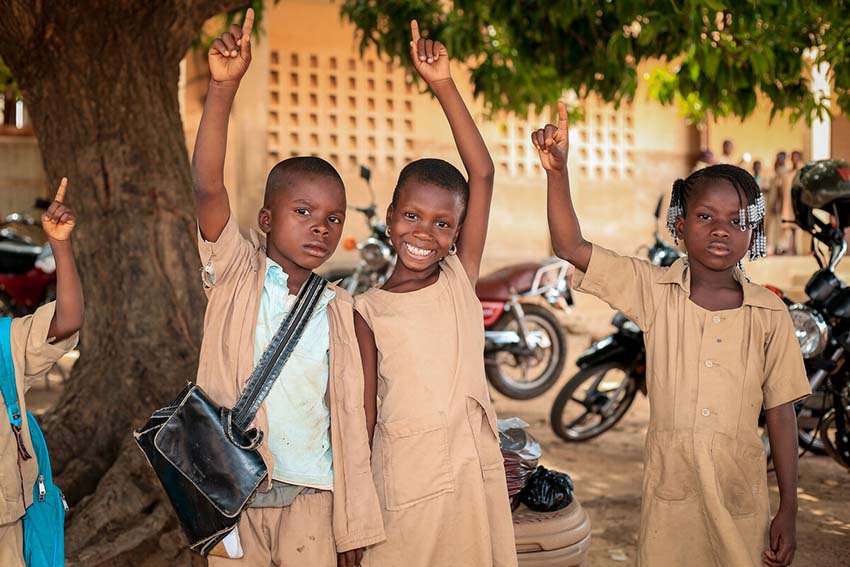
From left to right, Abdoulaye, 10, Abiba, 8, and Marie, 9, are students at the Arafat Public Primary School in Benin. They are raising their fingers to show their agreement to participate in a survey measuring the prevalence of schistosomiasis and soil-transmitted helminthiasis among primary school students. The survey was administered as part of the Act to End Neglected Tropical Diseases (NTDs) | West project, which is funded by the U.S. Agency for International Development and led by FHI 360. Photo credit: Rodrigue Olympio for FHI 360
As 2023 came to a close, global donors joined together to pledge US$777.2 million to accelerate progress toward eliminating certain neglected tropical diseases (NTDs).
The groundbreaking move, announced during the Reaching the Last Mile Forum in December, is aimed at achieving the goals outlined in the 2030 road map on NTDs developed by the World Health Organization (WHO). But will donors, partners and countries consider the right issues to ensure that this funding is used to achieve those goals?
What makes a disease ‘neglected’?
NTDs are a diverse group of 20 conditions caused by a variety of pathogens — viruses, bacteria, parasites, fungi and toxins. They are termed “neglected” because they are most prevalent in rural and under-resourced communities, and they were omitted from the global health agenda for years. This led to a disproportionately small amount of money allocated to their control, elimination and eradication compared to the health burdens they cause.
NTDs affect about 1.65 billion people worldwide — more than HIV, tuberculosis (TB) and malaria combined. In 2021, more than 170 countries reported cases of at least one NTD. Yet funding challenges persist, as these rightly named conditions have received a fraction of the global investments into HIV, TB and malaria.
A historic pledge for long-neglected diseases
Despite the ongoing lack of funding for NTDs, the global public health community can support ministries of health to reduce their burden. To date, 50 countries have eliminated at least one NTD.
The recent funding pledge is a milestone in the journey to NTD elimination, with an especially strong focus on eliminating two NTDs, lymphatic filariasis (or elephantiasis) and onchocerciasis (or river blindness). Lymphatic filariasis affects over 120 million people in 72 countries, and onchocerciasis has infected an estimated 18 million people and blinded 270,000. Both have devastating morbidities, which can lead to physical disability and often subject those with the conditions to social stigma, leading to mental, social and financial losses.
Why target these two NTDs?
Lymphatic filariasis and onchocerciasis are already close to elimination in many countries, so strong support now can ensure that we reach the WHO road map’s 2030 goals. Furthermore, preventative treatment is straightforward; the usual barrier is the cost of the drugs. Both are identified as PC-NTDs (PC for preventive chemotherapy), meaning that their transmission and associated morbidity can be reduced by regular, large-scale administration of drugs (as recommended by the WHO).
The funding pledge will, among other things, be used to provide these drugs, which can prevent, treat and eliminate these NTDs — enabling countries and partners to make an immediate impact.
From pledge to populace
The pledge puts “reaching the last mile” — or eliminating — lymphatic filariasis and onchocerciasis truly within reach. Given the historical lack of financial resources and the tremendous burden of these diseases, the stakes are high to effectively leverage this long-awaited increase in funding.
Here we outline essential issues to help ensure that the global effort to eliminate NTDs stays on course:
Preventing inefficiencies
There are true gaps that should be identified and filled using the new funding. For example, for onchocerciasis, understanding where the flies are breeding and changes to their ecologies is often a programmatic gap. For lymphatic filariasis, post-validation surveillance support is needed to ensure that recurrence is detected quickly.
With a financial commitment of this size, there is risk of duplication or inefficiency. NTDs need to be addressed both in terms of patient care as well as prevention and surveillance. Thorough assessments of existing funding commitments and new funding capacities should be undertaken to reveal the current and future gaps, enabling funding to be used most effectively.
To maximize the impact of their funding, donors should ensure that their other funding streams are optimized to also address NTDs. For example, malaria programs receive significant funding for vector control. Lymphatic filariasis is spread by the same vector: mosquitoes. With the right coordination, one funding source can address both diseases.
Strengthening multisectoral systems to fight other NTDs
Since the recent commitments focus mostly on onchocerciasis and lymphatic filariasis, the global health community must not neglect the 18 other NTDs. Paramount to this is embedding health systems strengthening efforts into disease elimination-specific efforts to ensure the other NTDs can be prevented, treated and managed.
The WHO’s NTD strategy includes strengthening health systems and collaborating across sectors — meaning that resources from other programs, such as those for malaria and HIV, count toward building the capacity of a health system to address NTDs. For this to work, high-level advocacy needs to demonstrate that collaboration and integration would be more effective if resources were less siloed.
Donors and countries should ensure that strengthening health systems is built into all donation programs. In time, using those resources in a collaborative way will translate into building the capacity needed to tackle other NTDs.
Putting full and healthy lives within reach
We are heartened by the funding pledge during the Reaching the Last Mile Forum. Now we must ensure the most efficient use possible of this infusion of resources. Through coordinating, optimizing and strengthening systems, the global community can indeed reach the last mile in eliminating NTDs, laying the foundation for a healthier future.
